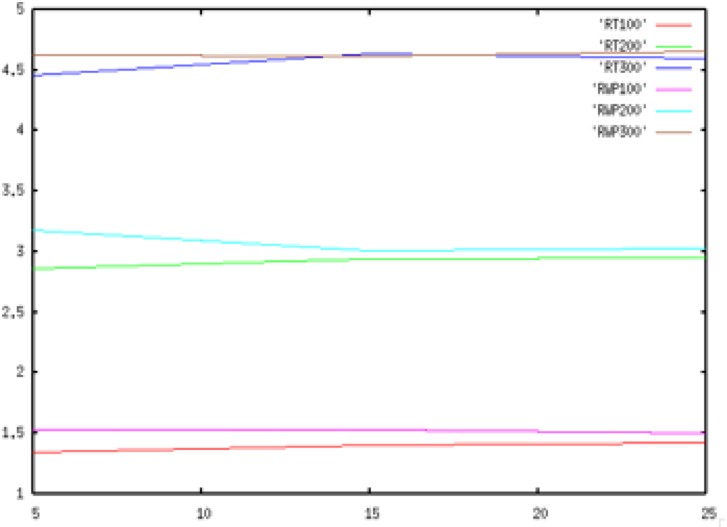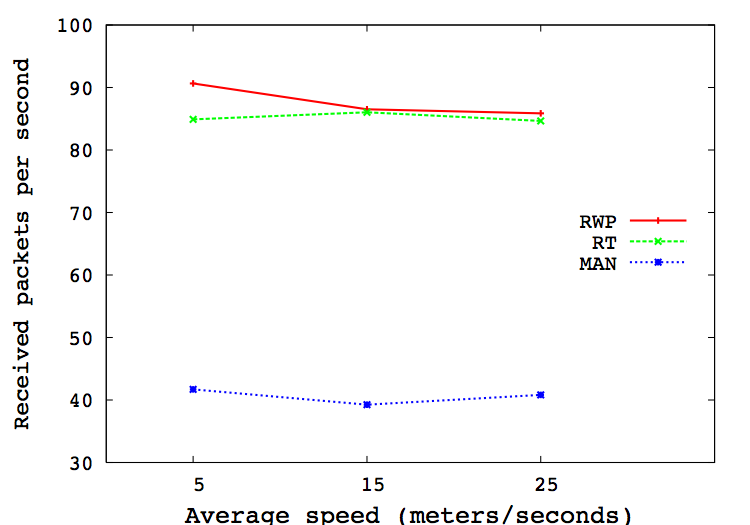Summary Diffusion Overhead
|
|
The study of the communication overhead of the diffusion protocols is important
from two different points of view. First, the evaluation of the traffic generated
helps us to understand the requirements imposed on the underlying
vehicular communication technology, and to determine if MobEyes can
coexist with other applications.
Second, the investigation of the impact of the parameters identified
in the previous section discloses possible tradeoffs between protocol
effectiveness and overhead. With regard to the latter perspective, the parameter
k shows the largest impact on the performance; the effect due to a small number
of agents is negligible, since they are only responsible for local 1-hop traffic.
The Figure below shows the average received packets per node per second,
obtained during a simulation time of 1000 seconds. In this set of simulations, we fixed k=1, and changed
all the other parameters, i.e., mobility model (RWP, MAN, RT), N (100, 200, 300), and
v (5, 15, 25). As expected, the number of received packets linearly increases as the number
of nodes increases, while it is independent from v.
The latter result could mislead to conclude that speed increments
would not impact the harvesting latency, since the number of received
packets would not change. This apparently invalidates
our previous results (see a=1,k=1), and
should be explained as follows. For a fixed
advertisement interval, as average speed increases, the probability
of useful meetings (i.e., of receiving a non-redundant summary)
increases because there is more mixing among mobile nodes. For example, given
a relative speed v, let us assume that the average period that
any two nodes are within their communication ranges simply be
2R/2v. Then with v of 5 and 25 m/s, and R=250m, the periods
can be estimated as 50 and 10 seconds respectively. This implies that the cases of 5 m/s
has roughly 5 times higher chances of receiving redundant advertisements
than the case of 25 m/s. It is interesting to note that, fixed the
average speed, there exists an optimal advertisement period allowing
to maximize non-redundant summary diffusion, while minimizing the overhead.
It will be part of our future work to analytically determine this value.
In all considered cases, the overhead is limited, on the order of few (one to five) packets per second,
proving the low impact of MobEyes on the available bandwidth.
It is interesting to note that MAN shows an overhead far
lower than the other two mobility models. This is due to the stationary distribution of
nodes in the field achieved by the different models. RWP suffers from the well known tendency
to gather nodes in the center of the simulated area. By using the road distribution of the
Westwood map, also RT tends to aggregate cars in a limited area (the south-easter) presenting
the largest concentration of tracks. As a consequence, the actual density appears much higher in
these models than the average density calculated in uniform conditions.
On the other hand, MAN effectively achieves the most uniform
node distribution. These intuitions are further confirmed by an offline analysis of the mobility traces.
The Figure above shows the magnifying effect produced by an increase of the parameter k.
k-hop relaying produces an enlargement of the area where summary packets are diffused
intuitively proportional to k^2. Consequently, also the number of nodes affected by a single
summary diffusion will be about k^2 larger than the single-hop case. Moreover, while in the
single-hop case, nodes receive any summary packet only once, with k-hop relaying any
node within k-hops from the originator
receives it a number of times proportional to the number of its neighbors. Thus, the total overhead
is expected to increase by a factor larger than k^2 but lower than k^2 times the average
number of neighbors (please note that k-hop distant nodes do not relay packets, thus reducing
the latter factor for k-hop as well as k-1-hop distant nodes).
The combination of these results with those in Figure multiple agent,k>1 lead us to conclude that
parameter k permits to decrease harvesting latency (about 20-30\% for k=3) at the price
of overhead increase (around 15-20 times). The importance of either
factor and the proper balance of their tradeoff can be only decided
depending on specific characteristics and requirements of the supported
urban monitoring application.

